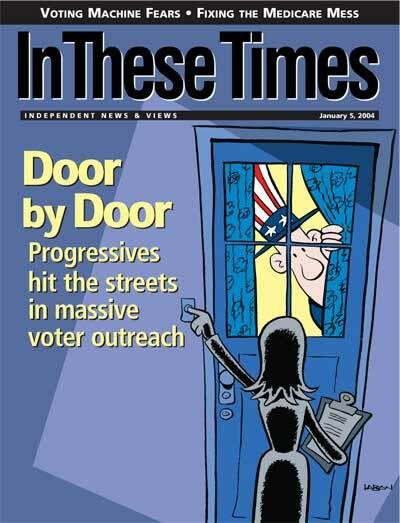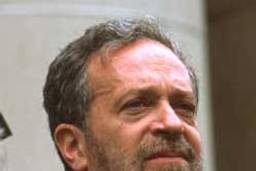
By reputation Massachusetts is the most Democratic state in the country, with good reason—its entire congressional delegation is Democratic, as are 171 of the state’s 200 legislators.
Despite this overwhelming majority, many progressives have been disenchanted as conservative Democrats held sway. But after a decades-long retreat into the political wilderness they are now deploying innovative grassroots strategies that could reshape politics in Massachusetts—and provide a model for the nation.
“[Legislators] have failed to enact any of the progressive planks in the party platform, including universal single-payer health care and clean elections,” says Leo Maley, a progressive union and community activist from Amherst.
Rather than giving up and backing third-party protest candidates, Maley and other progressives are seeking to make ideological inroads by increasing their numbers within the Democratic Party. Their principal target now is the state’s House of Representatives, where, they believe, a shift of 25 seats could be enough to make the House a decidedly progressive place. “If that happens it will be an earthquake,” he says.
Three organizations epitomize this search for new ways to conduct politics and foster civic engagement: Neighbor-to-Neighbor, Boston Vote and Progressive Democrats of Massachusetts.
The Boston-based Neighbor-to-Neighbor organization began in 1996 after an analysis showed that 47 House districts ought to have more progressive representatives than they had. Using grassroots organizing, leadership development, electoral campaigns, legislative lobbying and voter registration and education, the group “built power” in low-income and working-class communities.
Neighbor-to-Neighbor now boasts an impressive record of turning around the problem of low levels of voter participation in lower-income urban communities. The group was able to dramatically increase 2002 voter turnout in low-income precincts of several cities: These included increases of 185 percent in Salem, 900 percent in Lynn; 210 percent in Leominster; 589 percent in Fitchburg; and 131 percent in Worcester. Such remarkable successes have contributed to the election of progressive candidates in several cities as well as two progressive democratic members of Congress, Rep. James McGovern of Worcester and Rep. John Tierney of Gloucester. Sustained organizing by Neighbor-to-Neighbor in Worcester, Salem and Holyoke was credited as the deciding factor in the 2003 election of progressive, Latino city councilors in those cities.
“Since 1997 we have unelected or swung a large bloc of the target legislators,” says Executive Director Harris Grubman. He admits another 25 are needed to make the House a reasonably progressive place, but that goal is in sight. “There is nothing quite like the persuasive impact of seeing your colleagues go down.”
Neighbor-to-Neighbor’s success is based on “targeted organizing” in low-income communities around what it calls “The Working Family Agenda.” As the group’s Web site puts it, this agenda—“good jobs, education and training, affordable child care, health care and housing, and a welfare safety net”—is the cornerstone of their program. Neighbor-to-Neighbor’s methods include year-round intensive voter contact and issue mobilization across the election cycle, followed by personal, telephone and mail contact during electoral campaigns. “With year-round voter engagement,” Grubman says, “you change the equation dramatically. Most people don’t pay much attention to politics until the presidential campaign comes around.”
Another different and innovative model with electoral implications has been pioneered by Boston Vote, a nonprofit, tax exempt organization founded in 1999 to encourage social service and other nonprofit agencies in low-income urban areas to register their clients to vote and help to turn them out on election day. Boston Vote is, in its way, targeting the same kinds of communities as Neighbor-to-Neighbor, but their main method has been to encourage nonprofit service organizations to integrate non-partisan voter registration and mobilization into their existing programs. Boston Vote and several participating agencies have received major foundation funding to develop a civic education program to increase voter participation among low-income communities of color. Some 140 groups participate in the program, of which about 50 are very active.
“We’ve gotten out the message that these nonprofits really depend on voter turnout in order to get their voices heard, to fulfill their missions and to receive continued funding,” says George Pillsbury, policy director of Boston Vote. “What progressives have done over 30 years is set up good nonprofit organizations that have grown out of various pieces of liberal legislation—organizations that the communities fundamentally trust.”
These efforts have ratcheted up voter participation in the targeted communities, Pillsbury says, which is responsible for the reelection of Felix Arroyo, a Latino Boston councilor. “Voter turnout in the black, Asian and Latino communities went up 80 percent, while [turnout in] the while communities went down 12 percent,” Pillsbury says. “Felix Arroyo came in second in a field of 5 [for four seats], because our precincts turned out.”
Progressive Democrats of Massachusetts (PDM) grew out of the 2002 gubernatorial campaign of former U.S. Secretary of Labor Robert Reich—whose spirited yet unsuccessful bid for the Democratic nomination attracted thousands of previously alienated and uninvolved progressives. After Republican Mitt Romney defeated Democratic regular Shannon O’Brien in the general election, some former Reich supporters decided to create a permanent progressive electoral organization that would continue to invite progressives into the party, and train leaders and activists with the goal of increasing the political and electoral power of the progressive wing of the Democratic Party.
PDM has quickly grown beyond the initial group of Reich supporters. Local organizing committees have been formed in a dozen towns and cities, including Gloucester, Lexington, Worcester, Springfield, Amherst and Williamstown. The secret of the group’s success to date is the organizing method of PDM board member Marshall Ganz, a former top organizer for the United Farm Workers who is now teaching at Harvard. Ganz’s method focuses on one-on-one recruiting, the development of personal political relationships and leadership training—all aimed at expanding the pool of progressive voters and activists. According to fellow PDM leader Joan Lancourt of Boston Ganz’s model is “based on the cumulative experiences and best practices of a long, proud history of American efforts at progressive organizing—the union movement, civil rights, the women’s movement and a wide array of community-organizing approaches.”
While these initiatives hold great promise, they all have arisen from a resurgent progressive movement in the state and are building on the work of other organizations, notably the statewide Commonwealth Coalition. Its 22 member organizations of unions and women and environmental groups engage in more traditional electoral campaigns and have trained thousands of activists in the past 15 years. The coalition also was instrumental in creating a progressive caucus of state legislators.
Such efforts have made headway, but many progressives feel it’s long past time to make Democratic values real in public policy.
“If we are going to have political party,” says Grubman, “ it needs to mean something.” The next few years will be pivotal in determining what that will be.
Despite this overwhelming majority, many progressives have been disenchanted as conservative Democrats held sway. But after a decades-long retreat into the political wilderness they are now deploying innovative grassroots strategies that could reshape politics in Massachusetts—and provide a model for the nation.
“[Legislators] have failed to enact any of the progressive planks in the party platform, including universal single-payer health care and clean elections,” says Leo Maley, a progressive union and community activist from Amherst.
Rather than giving up and backing third-party protest candidates, Maley and other progressives are seeking to make ideological inroads by increasing their numbers within the Democratic Party. Their principal target now is the state’s House of Representatives, where, they believe, a shift of 25 seats could be enough to make the House a decidedly progressive place. “If that happens it will be an earthquake,” he says.
Three organizations epitomize this search for new ways to conduct politics and foster civic engagement: Neighbor-to-Neighbor, Boston Vote and Progressive Democrats of Massachusetts.
Neighbor-to-Neighbor
The Boston-based Neighbor-to-Neighbor organization began in 1996 after an analysis showed that 47 House districts ought to have more progressive representatives than they had. Using grassroots organizing, leadership development, electoral campaigns, legislative lobbying and voter registration and education, the group “built power” in low-income and working-class communities.
Neighbor-to-Neighbor now boasts an impressive record of turning around the problem of low levels of voter participation in lower-income urban communities. The group was able to dramatically increase 2002 voter turnout in low-income precincts of several cities: These included increases of 185 percent in Salem, 900 percent in Lynn; 210 percent in Leominster; 589 percent in Fitchburg; and 131 percent in Worcester. Such remarkable successes have contributed to the election of progressive candidates in several cities as well as two progressive democratic members of Congress, Rep. James McGovern of Worcester and Rep. John Tierney of Gloucester. Sustained organizing by Neighbor-to-Neighbor in Worcester, Salem and Holyoke was credited as the deciding factor in the 2003 election of progressive, Latino city councilors in those cities.
“Since 1997 we have unelected or swung a large bloc of the target legislators,” says Executive Director Harris Grubman. He admits another 25 are needed to make the House a reasonably progressive place, but that goal is in sight. “There is nothing quite like the persuasive impact of seeing your colleagues go down.”
Neighbor-to-Neighbor’s success is based on “targeted organizing” in low-income communities around what it calls “The Working Family Agenda.” As the group’s Web site puts it, this agenda—“good jobs, education and training, affordable child care, health care and housing, and a welfare safety net”—is the cornerstone of their program. Neighbor-to-Neighbor’s methods include year-round intensive voter contact and issue mobilization across the election cycle, followed by personal, telephone and mail contact during electoral campaigns. “With year-round voter engagement,” Grubman says, “you change the equation dramatically. Most people don’t pay much attention to politics until the presidential campaign comes around.”
Boston Vote
Another different and innovative model with electoral implications has been pioneered by Boston Vote, a nonprofit, tax exempt organization founded in 1999 to encourage social service and other nonprofit agencies in low-income urban areas to register their clients to vote and help to turn them out on election day. Boston Vote is, in its way, targeting the same kinds of communities as Neighbor-to-Neighbor, but their main method has been to encourage nonprofit service organizations to integrate non-partisan voter registration and mobilization into their existing programs. Boston Vote and several participating agencies have received major foundation funding to develop a civic education program to increase voter participation among low-income communities of color. Some 140 groups participate in the program, of which about 50 are very active.
“We’ve gotten out the message that these nonprofits really depend on voter turnout in order to get their voices heard, to fulfill their missions and to receive continued funding,” says George Pillsbury, policy director of Boston Vote. “What progressives have done over 30 years is set up good nonprofit organizations that have grown out of various pieces of liberal legislation—organizations that the communities fundamentally trust.”
These efforts have ratcheted up voter participation in the targeted communities, Pillsbury says, which is responsible for the reelection of Felix Arroyo, a Latino Boston councilor. “Voter turnout in the black, Asian and Latino communities went up 80 percent, while [turnout in] the while communities went down 12 percent,” Pillsbury says. “Felix Arroyo came in second in a field of 5 [for four seats], because our precincts turned out.”
Progressive Democrats of Massachusetts
Progressive Democrats of Massachusetts (PDM) grew out of the 2002 gubernatorial campaign of former U.S. Secretary of Labor Robert Reich—whose spirited yet unsuccessful bid for the Democratic nomination attracted thousands of previously alienated and uninvolved progressives. After Republican Mitt Romney defeated Democratic regular Shannon O’Brien in the general election, some former Reich supporters decided to create a permanent progressive electoral organization that would continue to invite progressives into the party, and train leaders and activists with the goal of increasing the political and electoral power of the progressive wing of the Democratic Party.
PDM has quickly grown beyond the initial group of Reich supporters. Local organizing committees have been formed in a dozen towns and cities, including Gloucester, Lexington, Worcester, Springfield, Amherst and Williamstown. The secret of the group’s success to date is the organizing method of PDM board member Marshall Ganz, a former top organizer for the United Farm Workers who is now teaching at Harvard. Ganz’s method focuses on one-on-one recruiting, the development of personal political relationships and leadership training—all aimed at expanding the pool of progressive voters and activists. According to fellow PDM leader Joan Lancourt of Boston Ganz’s model is “based on the cumulative experiences and best practices of a long, proud history of American efforts at progressive organizing—the union movement, civil rights, the women’s movement and a wide array of community-organizing approaches.”
While these initiatives hold great promise, they all have arisen from a resurgent progressive movement in the state and are building on the work of other organizations, notably the statewide Commonwealth Coalition. Its 22 member organizations of unions and women and environmental groups engage in more traditional electoral campaigns and have trained thousands of activists in the past 15 years. The coalition also was instrumental in creating a progressive caucus of state legislators.
Such efforts have made headway, but many progressives feel it’s long past time to make Democratic values real in public policy.
“If we are going to have political party,” says Grubman, “ it needs to mean something.” The next few years will be pivotal in determining what that will be.
Frederick Clarkson is a Massachusetts-based independent journalist. He is the editor, most recently, of Dispatches from the Religious Left: The Future of Faith and Politics in America (Ig Publishing, 2008).







